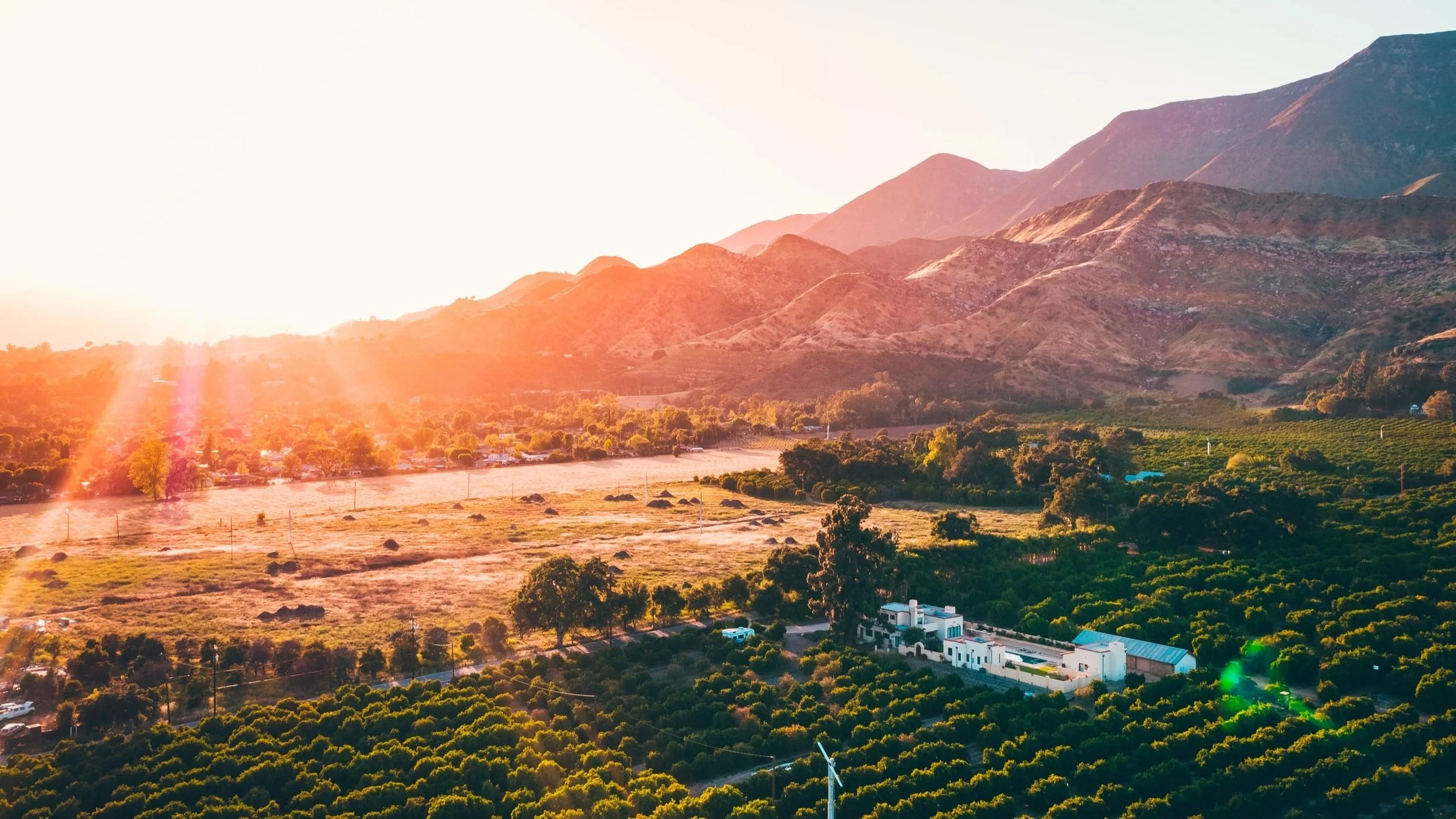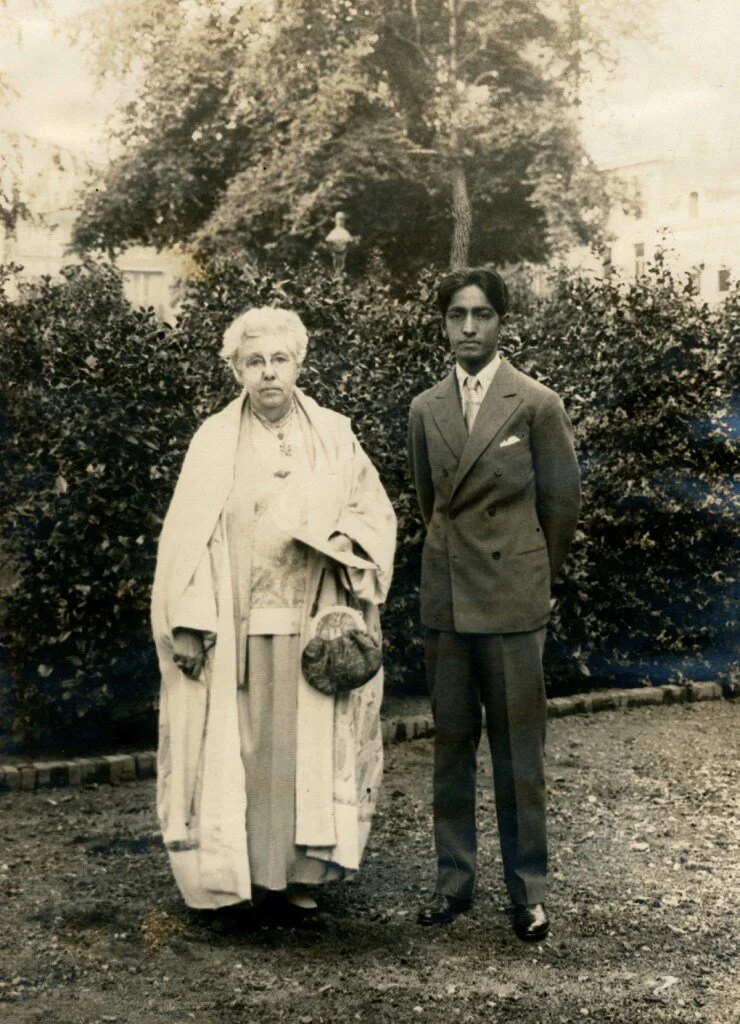A short history of Ojai
Nestled in a rare east–west valley surrounded by the Topatopa Mountains, Ojai has long drawn people in — not just for its immense natural beauty, but for an almost magnetic sense of spiritual energy. This is a short history of our quietly iconic town, and some of the people and places that have helped shape it over the years.
First things first: Ojai is pronounced “O-hi” – just in case you were wondering. For thousands of years, the Chumash people considered the valley sacred — a fertile, sheltered place that provided food, safety, and spiritual grounding. They lived along the Southern California coast as far back as 7,000 BC, fishing, gathering, and practicing sophisticated basket weaving and rock art traditions that still inspire today.
Modern Ojai began to take shape in the 19th century. In 1837, Fernando Tico was granted nearly 18,000 acres, which became “Rancho Ojai.” After briefly passing through the hands of oil speculators, the land was sold to settlers, and in 1873, R.G. Surdam laid out the townsite. He named it Nordhoff after Charles Nordhoff, author of California for Health, Pleasure and Residence — a nod to the valley’s early reputation as a place of healing and retreat.
Annie Besant and Jiddu Krishnamurti
A PLACE OF HEALING
True to its namesake’s inspiration, the small town soon became known as a place of healing, attracting both pioneers seeking a healthy place to live and wealthy Easterners wanting to while away the winter in a warm climate. In the 1880s Sherman Day Thacher came West to care for an ailing brother and soon started the Thacher School, with its ethos to “teach a boy to ride, shoot and tell the truth.” Thacher School today is one of the most prestigious preparatory academies in the US. By 1903, the exclusive Foothills Hotel was one of the top tourist resorts in California and regular visitors included Edward and Florence Libbey of the Libbey Glass Company in Ohio, who in 1911 moved here permanently and changed the town forever. For Libbey invested heavily, hiring San Diego architects Frank Mead and Richard Requa to construct many of Ojai’s signature Spanish Colonial Revival style structures and creating what is now known as downtown. Stroll along Ojai Avenue today and you’ll still see his buildings, including the Arcade, the Post Office Tower, the Ojai Valley Inn (formerly the Ojai Valley Country Club) and the eponymous Libbey Park. After the facelift was completed in 1917, the town of Nordhoff changed its name to Ojai.
SPIRITUAL MECCA
In the 1920s, Ojai’s identity as a spiritual destination was solidified with the arrival of Theosophist Annie Besant and her protégé Jiddu Krishnamurti. The valley quickly became a magnet for spiritual seekers, artists, and thinkers. Visitors included Aldous Huxley, Dr. David Bohm, Jackson Pollock, and Christopher Isherwood, along with Hollywood icons like Greta Garbo and Charlie Chaplin. Though Krishnamurti later distanced himself from the Theosophical Society, his teachings left an indelible mark. His legacy lives on through the Krishnamurti Foundation of America, Oak Grove School, and a continued reverence for inquiry-based education.
From the 1920s to the 1940s construction and growth in Ojai continued to boom, as many churches, schools, fire stations, art centers, libraries, shops, restaurants and hotels as well as beautiful homes were built across the valley. The town continued to attract creative and spiritual folks and in 1948, renowned Avant-garde and Dada artist Beatrice Wood set up a pottery studio in Ojai, which she later moved to the Happy Valley school (now Besant Hill) and where she taught ceramics and continued working to the ripe old age of 104. The studio still exists today.
A TASTE FOR CHANGE
Meanwhile on the culinary front, Alan and Helen Hooker settled in Ojai in the 1940s following Krishnamurti and having left a commune in Ohio, where they were studying Asian philosophy and had learned to embrace vegetarianism. In 1956, the couple opened the still operating Ranch House Restaurant in Meiners Oaks, where vibrant, fresh, garden-picked food was a bellwether of the now ubiquitous California Cuisine.
The 1960s saw some troubles between hippies and locals but more notably the opening of iconic outdoor bookstore Bart’s Books by Richard Bartindale on the corner of West Matilija and Canada Streets in 1964, as well as the arrival of Florence Garrigue, who came to set up Meditation Mount to “promote the building of an enlightened and compassionate world through the power of creative meditation.” Both continue to thrive today.
TODAY’S OJAI
Over the decades the Ojai Valley has continued to grow and expand: schools, galleries, parks, public buildings and businesses have been created making Ojai a thriving town and community. Thanks to a city-wide ban on chain stores and restaurants, which was adopted in 2007, Ojai has been able to retain its quaint and distinct character that appeals to people looking for something uniquely different.
Many a celebrity has chosen the Ojai Valley as a tranquil pied-à-terre: from stars of yesteryear like Johnny Cash to Hollywood A-listers including Anthony Hopkins, Reese Witherspoon and Liv Tyler. But Ojai’s magic doesn’t lie in who lives here. It’s in its deep cultural and spiritual roots, its wildly beautiful natural landscape, its community-run businesses, and its sense of being a little apart from the world. This site exists to celebrate all of it — past and present, visible and quietly unfolding.




